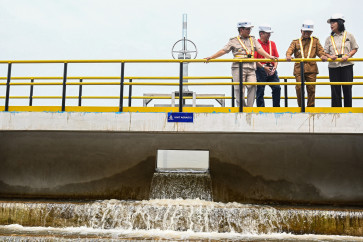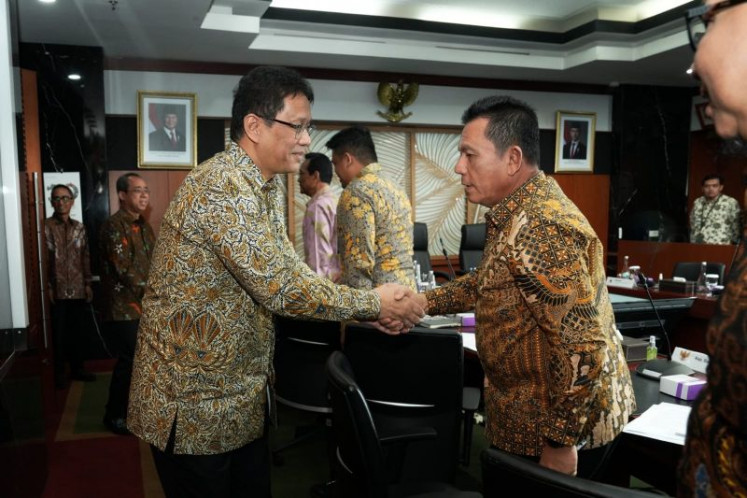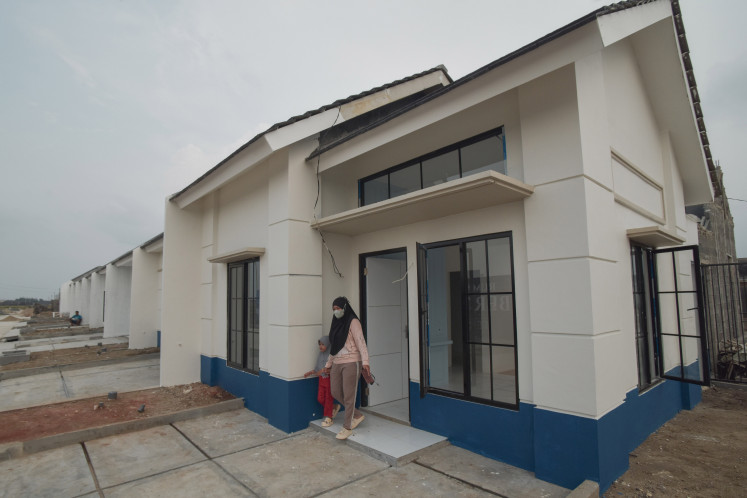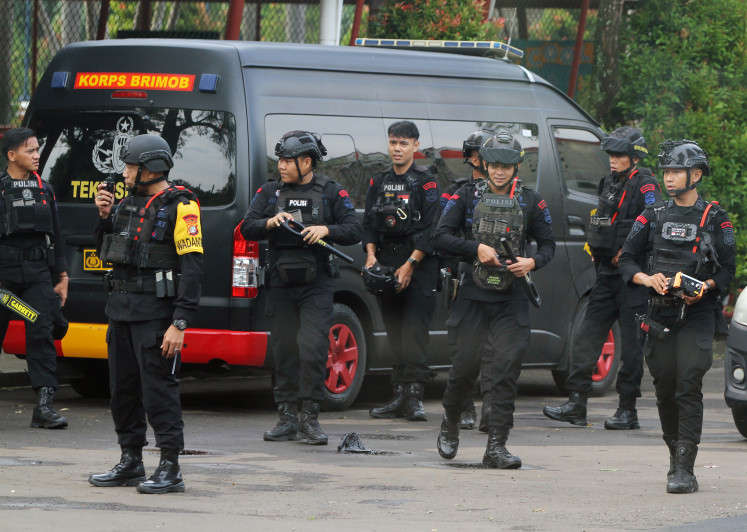Popular Reads
Top Results
Can't find what you're looking for?
View all search resultsPopular Reads
Top Results
Can't find what you're looking for?
View all search resultsBorobudur as a high-resolution simulacra
âBorobudur is a place where man meets the divine within himself,â says Titus Leber of the Buddhist temple that sits 40 kilometers from Yogyakarta in Magelang, Central Java
Change text size
Gift Premium Articles
to Anyone
 Gargantuan: The final project is immense, including 65 Gigabytes of data. It includes 400 interactive files that offer viewers 360-degree panoramic views of aspects of the temple. (Courtesy Taman Wisata Candi Borobudur)" border="0" height="280" width="498">
Gargantuan: The final project is immense, including 65 Gigabytes of data. It includes 400 interactive files that offer viewers 360-degree panoramic views of aspects of the temple. (Courtesy Taman Wisata Candi Borobudur)" border="0" height="280" width="498">âBorobudur is a place where man meets the divine within himself,â says Titus Leber of the Buddhist temple that sits 40 kilometers from Yogyakarta in Magelang, Central Java.
For most tourists, a visit to the temple, which first came to European attention in 1814, takes less than a day. However, for Leber, an Austrian-born writer, director and multimedia creator, it took significantly longer.
He spent four years developing Borobudur: Paths to Enlightenment, a virtual encyclopedia cataloging all of the stories depicted on every one of the templeâs panels.
âIn every sense of the word, Borobudur is a gold mine,â he said.
It is the largest Buddhist complex in the world. The temple, designated a UNESCO landmark, has 1,460 bas-reliefs that depict more than 15,000 characters.
Since restoration, work at the complex began, Borobudur has become a major site for Buddhists and a destination for local and international tourists.
Leber was inspired to digitize the wisdom of the templeâs panels for pilgrims and tourists who might not understand the rich stories contained therein.
âPeople look at Borobudur and see a pile of dead stones â like an archeological artifact,â Leber says. âBut itâs not only a story in pictures. Borobudur is actually the equivalent of a large Hollywood movie.â
Visitors, Leber says, âleave the temple being aware they saw something fantastic but having not a clue what it wasâ.
The encyclopedia took four years to finish: two years onsite at Borobudur capturing and cataloging images and two years in post-production.
Leber said that he told officials at PT Taman Wisata Candi Borobudur, the private firm that manages the temple complex, that the project they offered him would be painstaking. âI said, âIf I do this project I do it thoroughlyâ.â
Leber, who has a doctorate in art history, began his career as a film director later moving into multimedia, producing work for the Louvre museum, IBM and the royal court of Thailand.
He continues: âLooking back now, itâs a miracle that we completed it. If this wasnât a government project we never could have done it.â
The final project is immense, including 65 Gigabytes of data. It includes 400 interactive files that offer viewers 360-degree panoramic views of aspects of the temple.
Viewers can explore the temple virtually, stopping to watch a slew of high-definition video sequences accompanied by the original texts that inspired the builders of the temple.
According to Leber, the process was labor intensive. âWe wanted our animation to consist only of original characters taken directly from the stone carvings on the temple walls. Each one of them needed to be die-cut, isolated and then to be animated along with a specially-composed soundtrack in several hundred layers of superimposed imagery.â
 <)
<)
'Borobudur is a place where man meets the divine within himself,' says Titus Leber of the Buddhist temple that sits 40 kilometers from Yogyakarta in Magelang, Central Java.
For most tourists, a visit to the temple, which first came to European attention in 1814, takes less than a day. However, for Leber, an Austrian-born writer, director and multimedia creator, it took significantly longer.
He spent four years developing Borobudur: Paths to Enlightenment, a virtual encyclopedia cataloging all of the stories depicted on every one of the temple's panels.
'In every sense of the word, Borobudur is a gold mine,' he said.
It is the largest Buddhist complex in the world. The temple, designated a UNESCO landmark, has 1,460 bas-reliefs that depict more than 15,000 characters.
Since restoration, work at the complex began, Borobudur has become a major site for Buddhists and a destination for local and international tourists.
Leber was inspired to digitize the wisdom of the temple's panels for pilgrims and tourists who might not understand the rich stories contained therein.
'People look at Borobudur and see a pile of dead stones ' like an archeological artifact,' Leber says. 'But it's not only a story in pictures. Borobudur is actually the equivalent of a large Hollywood movie.'
Visitors, Leber says, 'leave the temple being aware they saw something fantastic but having not a clue what it was'.
The encyclopedia took four years to finish: two years onsite at Borobudur capturing and cataloging images and two years in post-production.
Leber said that he told officials at PT Taman Wisata Candi Borobudur, the private firm that manages the temple complex, that the project they offered him would be painstaking. 'I said, 'If I do this project I do it thoroughly'.'
Leber, who has a doctorate in art history, began his career as a film director later moving into multimedia, producing work for the Louvre museum, IBM and the royal court of Thailand.
He continues: 'Looking back now, it's a miracle that we completed it. If this wasn't a government project we never could have done it.'
The final project is immense, including 65 Gigabytes of data. It includes 400 interactive files that offer viewers 360-degree panoramic views of aspects of the temple.
Viewers can explore the temple virtually, stopping to watch a slew of high-definition video sequences accompanied by the original texts that inspired the builders of the temple.
According to Leber, the process was labor intensive. 'We wanted our animation to consist only of original characters taken directly from the stone carvings on the temple walls. Each one of them needed to be die-cut, isolated and then to be animated along with a specially-composed soundtrack in several hundred layers of superimposed imagery.'
For the Austrian, the project has been about inspiring people to learn more than what a tour guide can offer as well as translating the temple's ancient messages of wisdom and compassion into a visual language for wider audiences to appreciate.
'I think many people here are not even aware or have a clue of the wealth of Borobudur ' of what this country is sitting on,' he said.
Photographing the panels took over a year and the temple was shot in its entirety three times: for panoramas, detailed close-ups and general shots of each panel.
For Leber, capturing the sublime and the play of light across Borobudur's stone carvings was the hardest task of all. 'Sun and moon, the fleeting clouds and the change of seasons are the animators of this spectacle in which every character, every facial expression changes from one moment to the next as in a dream-like movie.'
The interactive panoramas comprise 120 digital images that have been stitched together and can be previewed from a single menu screen.
However, Leber says that the price of the coffee table book that he has may be too high for casual readers, although he said he hoped PT Taman Wisata would produce a server-based version.
'At the moment it's just a collector's edition, which makes it mostly available just for universities,' Leber said. 'I hope we'll get the chance to do a scaled-down version, for mobile devices, like iPhones, iPads and so on. We are discussing this.'
As he previously told The Jakarta Post. 'We're living in a world of so many extremes, while Buddha has always taught the middle way, the way of tolerance. The whole of Borobudur is about that ' and that's the message I want to bring to the world in every modern medium.'
'I see my job as basically translating old visuals to new visuals, stone visuals into multimedia animations,' Lebar says. 'I want to bring the Borobudur to the world, and bring the world to Borobudur.'
The writer is an intern at The Jakarta Post.










